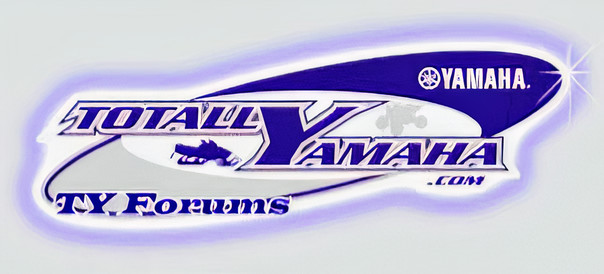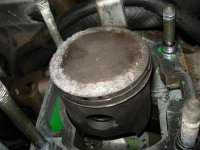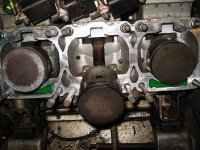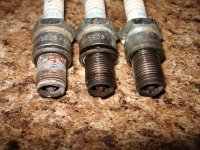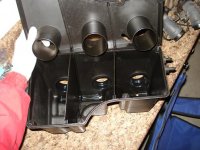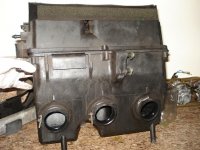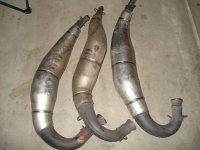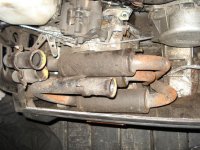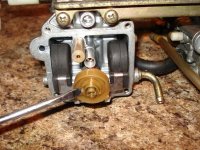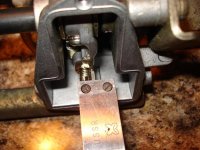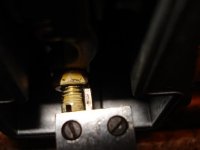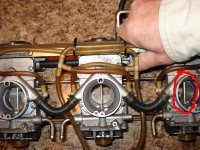I’ve just purchased a 1998 Yamaha SRX 700 with 1600 miles (I didn’t start it) on it from the original owner. Owner warned me that the engine might have to be rebuilt (I do not know if it is relevant or not but the sled is equipped with separate exhaust pipes for every cylinder, each expansion pipe has its own silencer). There is a knocking sound when rotated the clutch (crank) by hand. Measured the PSI in the cylinders (when sitting on the sled the left cylinder =120, center=120, right=30 psi). Pulled off all three heads and here is what I discovered: the left and the center pistons (120 psi) look great while the top of the right one (30 psi) is white in color and looks like someone was heavily chipping it off around the edges. In addition to that connecting rod has about a ¼ inch play on the crank shaft (explains the knocking noise). When I looked at the other connecting rods I could see the needle bearings between the crankshaft and the rod wile the damaged piston connecting rod looked like it was missing that bearing at all (probably came apart due to abuse). I am planning on installing new pistons and rebuilding the crankshaft (taking it to the shop) to resurrect this SRX. What bothers me the most is even though the problem is obvious the case is still unknown to me what I really want to avoid is rebuilding the engine and than having it damaged again due to the initial problem not being corrected. Can anyone give me an advice or an idea what could have cased this damage to the piston and connecting rod. Thank you.
Attachments
Last edited:
It looks like the bearing let go and the piston hit the head. With the low miles on the sled, i would guess its from moisture getting to the bearings from sitting in storage.
more then likely either the the crankseal went bad, or it developed a air leak by the reed blocks , carb boots etc. and leaned out that cylinder, and the piston is beat up on the edge because thats where detonation forms, the crank bearing will go because the mixture is run too lean(hot) and with detonation in that cylinder it pounds the bearing to death and causes failure. Detonation usually ruins entire set up in that cylinder. Since youll be splittling the cases anyways to rebuild the crankshaft youll install new crank seals anyways. Inspect the carb boots for cracking when you flex them, and of course youll be replacing the reed block gaskets with a rebuild.
Thank you all for the responces I will defenatelly check on the items mentioned by you. What still puzzlez me is that with the piston looking nucked the cylinder (top end) of the blown piston looks CRISP (with exception of microscopic scratches one or two) originally I thought that the owner replaced the cylinder but the outside looks consistent with other two. Another question that I have is could this lean condition be caused by improper carburator (mixture) setting? I don't know if this is relevent or not in this case but the sled has different silencers on it original owner said that he bought them at the show, when I asked him (owner) if he had to rejet the carbs he said that these silencers didn't need any rejecting they were "plug and play" (at least that what people at the show selling the silencers told him)
I would of course check/clean the carbs before you reassemble it but looking at your other 2 pistons the jetting looks to be ok.
the cylinder would have definitely gotten crisp for it to do what it did.
silencers dont require any rejetting.
the cylinder would have definitely gotten crisp for it to do what it did.
silencers dont require any rejetting.
How do I set up my mixture correctly. I will not screw around with the floats (I don't think I need to, or do I?) the only other settings that might get out of adjustment after cleaning are the fule/air mixture and the "idle" adjustments (on the top of the 2 side carburators and one main adjustment screw for the center carb) on all three carbs. Are there any specific instructions on how to get these settings in correct operating range. Also I looked at the carbs and there is one out of two screws that I can't identify: one is a small sloted yellow screw located under the air inlet (air box side) I think this is the air/gas mixture adjustment screw and the second screw (I don't know what this one is for) is a "silver" flat head screw located on the bottom side of the carbs. If you have any instructions on the carbs adjustment (after complete cleaning) and explanation for "unidentifyed" screw please let me know.
PS
I've sined up to this site this morning, I cannot express how helpful your responses have been, and the amount of information I received in the past 6 hours, thank you.
PS
I've sined up to this site this morning, I cannot express how helpful your responses have been, and the amount of information I received in the past 6 hours, thank you.
Check out the TY tech pages for some images of Carbs and stuff. The link is in my signature or can be found in the menu bar at the top of the page.
Yurly, you can change pilot jets, needle clip setting and main jet size in the carbs as well.
You need to determine what pipes are on that sled, you allude to the fact they may be aftermarket? You are aware that sled came factory with triple pipes as well? You can find the info as stated abave on the Tech Pages for the proper jetting for that sled with factory exhaust. If it is aftermarket, you can post here, someone will have the right info, but you need to know the brand of pipes. Post up some pics of them. Also look at the airbox and see if it has been modified and let us know. Any mods to the intact tract basically affect proper jetting, and may or may not require changes.
You need to determine what pipes are on that sled, you allude to the fact they may be aftermarket? You are aware that sled came factory with triple pipes as well? You can find the info as stated abave on the Tech Pages for the proper jetting for that sled with factory exhaust. If it is aftermarket, you can post here, someone will have the right info, but you need to know the brand of pipes. Post up some pics of them. Also look at the airbox and see if it has been modified and let us know. Any mods to the intact tract basically affect proper jetting, and may or may not require changes.
I took some pictures of the silencers, expansion chambers, plugs (the white plug came out of the bad cylinder) and air box. Unfortunately there are no markings on the silencers (I think they are not stock) as far as everything else please let me know if expansion chambers or air box look modified and might require rejetting.
Attachments
I opened the carburetors to inspect the jets sizes and stumbled on some pretty interesting things (to me at least) I wonder if any of my discoveries contributed to the piston failure. First thing first jetting: with reference to the rider sitting on the sled
Left carb Center carb Right carb (BAD cylinder)
Pilot jet 42.5 42.5 42.5
Main jet 148.8 145.3 146.3
After referencing the tech page on the site the stock pilot jets are (42.5) and the stock main jets are (1/2 - 146.3, 3-148.8 Please let me know if the jetting on my sled is acceptable for proper operations (taking in consideration the aftermarket silencers mentioned in the post above). Second: on the Right carb (BAD cylinder) the yellow washer (device sitting on the main jet I point to it with my screwdriver in the picture, I think it’s a filter of some sort) is very loose (I can easily spin it with my finger) compared to the other two carbs. What is this devise for and is it bad when it’s loose? Third: when I simulated full throttle (opened up all butterflies on the crabs) I noticed that the right carb needle (Bad cylinder carb) is sitting much lower that the other two (look at the picture of three carburetors) could that contribute to the cylinder failure? Forth and final: after noticing that the needle on the bad carb is sitting much lower compared to the rest of the carbs I popped off the top cover on all three carburetors and inspected the screw settings on the two outer crabs (Left and Right carbs the center carb didn't have a screw to adjust). After measuring the screw height on the Left carb (good cylinder) and comparing it to the screw height of the right carb (BAD cylinder) I found out that the screw height of the right carb (BAD cylinder) is about 1mm lower than the screw height of the left carb (this probably explains why the needle in the Right carb (Bad cylinder) sitts much lowere compared to the other two). Please let me know what your thought are on the information provided above, could the different jet numbers, different needle height or loose “washer” case the cylinder failure? Thank you.
Left carb Center carb Right carb (BAD cylinder)
Pilot jet 42.5 42.5 42.5
Main jet 148.8 145.3 146.3
After referencing the tech page on the site the stock pilot jets are (42.5) and the stock main jets are (1/2 - 146.3, 3-148.8 Please let me know if the jetting on my sled is acceptable for proper operations (taking in consideration the aftermarket silencers mentioned in the post above). Second: on the Right carb (BAD cylinder) the yellow washer (device sitting on the main jet I point to it with my screwdriver in the picture, I think it’s a filter of some sort) is very loose (I can easily spin it with my finger) compared to the other two carbs. What is this devise for and is it bad when it’s loose? Third: when I simulated full throttle (opened up all butterflies on the crabs) I noticed that the right carb needle (Bad cylinder carb) is sitting much lower that the other two (look at the picture of three carburetors) could that contribute to the cylinder failure? Forth and final: after noticing that the needle on the bad carb is sitting much lower compared to the rest of the carbs I popped off the top cover on all three carburetors and inspected the screw settings on the two outer crabs (Left and Right carbs the center carb didn't have a screw to adjust). After measuring the screw height on the Left carb (good cylinder) and comparing it to the screw height of the right carb (BAD cylinder) I found out that the screw height of the right carb (BAD cylinder) is about 1mm lower than the screw height of the left carb (this probably explains why the needle in the Right carb (Bad cylinder) sitts much lowere compared to the other two). Please let me know what your thought are on the information provided above, could the different jet numbers, different needle height or loose “washer” case the cylinder failure? Thank you.
Attachments
Last edited:
1.)the silencers are cpr or hauck ones, they are loud but do not require jetting changes, the pipes are stock yamaha units.
2.)the carbs are simply out of sync, you do just adjust the screw on top to bring all the slides up to the same level as you have already discovered.
3.)the jetting changes are not enuff to make it blow up as the smallest jet was in the center and not your problem cylinder, you again most likely have a bad crank seal and this is what lead to the fasilure, when the cylinder runs too lean it will start to detonate and this is what pounded the rod bearing to death.
2.)the carbs are simply out of sync, you do just adjust the screw on top to bring all the slides up to the same level as you have already discovered.
3.)the jetting changes are not enuff to make it blow up as the smallest jet was in the center and not your problem cylinder, you again most likely have a bad crank seal and this is what lead to the fasilure, when the cylinder runs too lean it will start to detonate and this is what pounded the rod bearing to death.
Thank you very much for the explanation, is there a way to inspect the crank seal (which crank seal are you talking about, where is it located?) and confirm that it is bad? For cab syncing adjusting the height screws will put the left and right carbs in sync, how do I sync the center carb with the outer two (there is no adjustment screw on it like on the outer once). Thank you.
yes, center slide is fixed,you adjust the other 2 slides to match the center one. I use a drill bit to guage the height of them, then check wide open to amke sure they are all up and clearing throat of carb, slides are up.
you will need to remove the recoil, flywheel and split the crankcase halves to get the crank seal out, it will be either dry and flaky with small deposits of rubber flaking off or melted and gooey, will be all red where the crank snout surface contacts the seal where as the rubber should be black.
you will need to remove the recoil, flywheel and split the crankcase halves to get the crank seal out, it will be either dry and flaky with small deposits of rubber flaking off or melted and gooey, will be all red where the crank snout surface contacts the seal where as the rubber should be black.
If I understand correctly the seal that might have gone bad separates the inside of the block (where the crank is) form the outside environment. In this case wouldn’t the whole crank be exposed to the leak? Why only one cylinder when out not all three? Any comment on the “loose” washer in the float camera of the carburetor (picture in my previous post where I point the screw driver towards it) on the main jet of the carburetor (damaged cylinder) what is this device for what is it function (the washer) does it need to be replaced if it’s loose on the main jet? Thank you.
no, the cylinder closest to the leak will be the lean cylinder on a crank seal.
the item inside the carb is to keep fuel around the mainjet, it keeps gas in the small well in the carb and keeps it from rolling away from the jet during take off, stops,etc, it wont hurt a thing as long as its on the crab when you replace the bowl, just install it(bowl) with carbs upside down so it cant fall out.
the item inside the carb is to keep fuel around the mainjet, it keeps gas in the small well in the carb and keeps it from rolling away from the jet during take off, stops,etc, it wont hurt a thing as long as its on the crab when you replace the bowl, just install it(bowl) with carbs upside down so it cant fall out.
fasttoys17
New member
^^^^^^^^^^^^^^^^^ i would listen to this guy he knows stuff 

Ok, got it thanks. Currently the motor is still in the engine bay (I am waiting for a clutch pull tool) can you tell me if it will require any special tools to get to the crank (pull the starter assembly and the fly wheel, etc) once I remove the motor out of the engine bay (if I do need special tools to get to the crank are you aware of any “tricks” to disassemble the motor without purchasing the special tools)? I am working on this sled with a buddy of mine (this is a first engine teardown for both of us) and he proposed an explanation why the sled sustained the damage that we are faced with. Out of your experience could you tell me if his hypothesis hold any ground. Here is his explanation: the sled was owned by one person before me, that person put 1600 miles on it and never had anything repaired or adjusted (according to the seller). After my resent discovery of the out-of-sync carb is it possible that this carb was out of sync for 1600 miles and eventually destroyed the bearing between the connecting rod and the crankshaft. The play in the bearing eventually lead to loss of compression and slow disintegration of the piston. Since all these conditions were ignored for 1600 miles we are now looking at completely destroyed bearing and horrible looking piston. Please let me know what you think about that. Thank you.
Again I want to thank you for providing lightning fast responses I am completely captured by this project and amount of information that you provide. 

I would disagree with your friends theory as the main jets have obviously been changed and I'm willing to bet that the same person improperly adjusted the needle by using the carb sync screws. If the needle is low enough, it could have resulted in a mid range lean condition and caused the melt down, I'm not sure how much would be too much for this though. Maybe Mrviper can confirm this or suggest how much would be too much. Either way, the seal is probably cooked. You should probably make sure the needles are in the stock locations while you have the carbs apart as well.
Last edited:
By saying “needles are in the stock location” you are referring to the needle clip position correct? According to the TY tech page the needle should be at position 3, I will check that out when I get home today. The carb cleaning article on this site talks about noticing the number of turns of the fuel screw (on the bottom of the carbs) and replicating that number of turns after the carb has been cleaned. Since someone has been fooling around with the crabs maybe they have fooled around with the fuel screw as well I want to avoid replicating an improper fuel screw setting. Article mentions that the setting of the fuel screw should be between 1.5-2 terns is there a special procedure for this fuel screw setting or I just set all 3 screws to the same position between 1.5-2 turns. In the other carb article on one of the pictures shown an Air Jet screw, should this air jet screw be taken out and cleaned, is there an adjustment on it, if yes what should the adjustment be and what is the procedure for it. Thank you.
